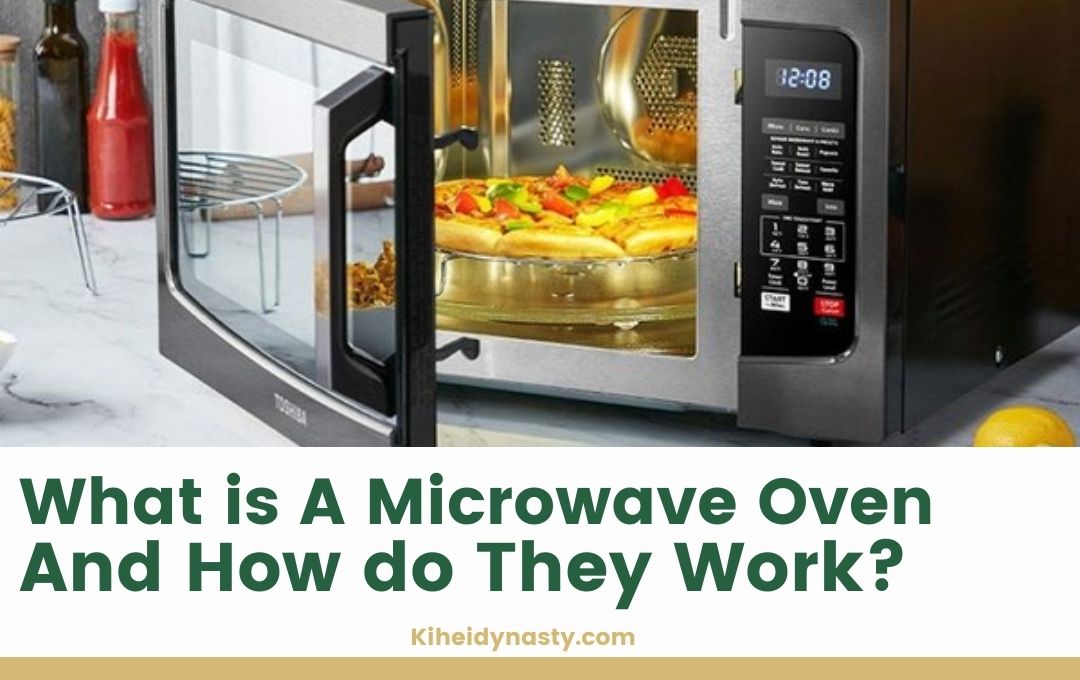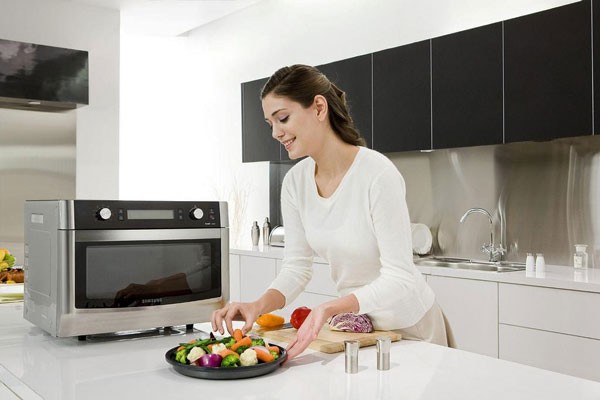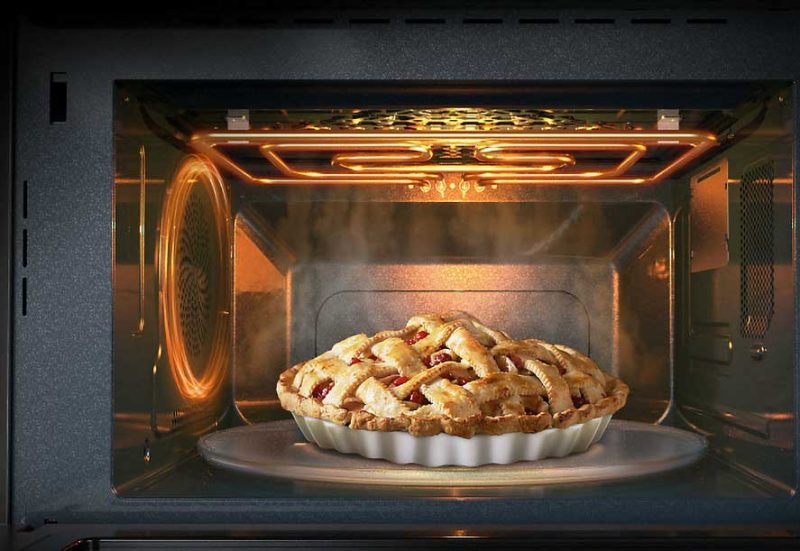Microwave ovens are one of the most popular kitchen appliances. They are used for various tasks, such as cooking, reheating, and melting butter. But what is a microwave oven, and how does it work? This blog post will answer those questions and more. Stay tuned!
What Is A Microwave Oven?

A microwave oven is a device that uses electromagnetic radiation to heat food and liquids. It works by producing short, high-energy waves of electromagnetic energy, which are then absorbed by the molecules in the food or liquid. These molecules begin to vibrate rapidly, causing them to heat up and cook.
Several different types of microwave ovens are available today, each with features and benefits. Some common types include countertop models, built-in units, and over-the-range microwaves. Regardless of the type you choose, a microwave oven can be a handy tool for quickly cooking your favorite foods and beverages.
Read more: Air Fryer Microwave Combo Reviews
How a Microwave Oven Works
While the exact mechanism may vary slightly depending on the type of microwave oven you use, all microwave ovens work essentially the same way. They consist of an electromagnetic field generator, called a magnetron, which produces short waves of electromagnetic radiation. These waves are then directed into an enclosed metal box, where they are absorbed by materials inside.
As these waves are absorbed and begin to vibrate the molecules in food or liquids, they produce heat that cooks your food or liquid from the inside out. This allows for faster cooking times than traditional cooking methods like boiling or roasting, making a microwave oven a practical and convenient appliance for any kitchen!
So if you’re looking for a quick and efficient way to cook your favorite foods at home, a microwave oven is the appliance. With its ability to cook food faster and more evenly than many other cooking methods, a microwave oven can help you easily prepare delicious meals. And with so many different models and features available today, it’s easy to find the perfect microwave oven for your needs!
Microwave Parts And Accessories
Along with the central unit, several different parts and accessories are commonly included with a microwave oven. These may include turntables, rotating fans, cooking racks, and defrost trays. Additionally, many modern models also come with advanced features like pre-programmed cook settings or built-in sensors that automatically adjust the power levels to produce optimal results for your food.
You may like: Best Air Fryer/Toaster Oven in 2022
Type Of Microwave Ovens

As mentioned earlier, several different types of microwave ovens are available today. The most common types include countertop models, built-in units, and over-the-range microwaves.
- Countertop Microwave Ovens: As their name implies, countertop microwave ovens are designed to sit on top of your kitchen counter. These models are typically less expensive than other types of microwaves, making them a popular choice for budget-conscious shoppers. Additionally, they come in a wide range of sizes and features to suit your needs.
- Built-In Microwave Ovens: Built-in microwave ovens are designed to be installed into your kitchen cabinets or shelving. These models tend to be more expensive than countertop models, but they offer a sleek, integrated look that can complement any kitchen décor. Additionally, many built-in microwaves have advanced features like sensors and pre-programmed cook settings.
- Over-The-Range Microwave Ovens: Over-the-range microwave ovens are designed to be installed above your stove. These models offer the convenience of having your microwave within easy reach and freeing up valuable countertop space in your kitchen. Over-the-range microwaves also come with additional features like exhaust fans and built-in lighting.
Benefits of Using a Microwave Oven
There are many benefits to using a microwave oven, including faster cooking times, heating, and easy cleanup. With its ability to quickly cook your food from the inside out, a microwave oven allows you to enjoy delicious meals in less time than traditional methods like roasting or boiling. What’s more, most models also feature advanced features like pre-programmed cook settings and sensors that automatically adjust power levels for optimal results. And thanks to their convenient size and design, microwave ovens can be easily incorporated into any kitchen layout.
Downsides of Using a Microwave Oven
While there are many advantages to using a microwave oven, there are also some potential disadvantages. For example, microwaves can sometimes cause food to become overcooked or dried out. Additionally, they may not be as effective at browning or crisping food as other methods like grilling or baking. And finally, microwaves can produce harmful electromagnetic radiation, so it’s important to follow the manufacturer’s instructions carefully and never operate the oven empty.
Energy Efficiency Of Microwave Ovens
Another important consideration when choosing a microwave oven is its energy efficiency. As with any appliance, the more energy-efficient your microwave oven is, the lower your electricity costs will be over time. To determine the energy efficiency of a particular model, look for information on things like power levels and pre-programmed cook settings, as well as features that help reduce standby power consumption, such as turn-off timers or auto shutoffs.
Microwave ovens use 775 to 1,100 watts of electricity on average. This is higher than a refrigerator but lower than a clothes iron. A typical household consumes roughly 200 kWh per year, which is more than a color television but less than an electric oven.
How to Use a Microwave Oven

Using a microwave oven is relatively simple and straightforward. First, you’ll need to choose the appropriate cookware for your food. Microwave-safe dishes are typically made from glass, ceramic, or plastic and are clearly labeled. Once you’ve selected your cookware, place your food inside and add any seasonings or sauces as desired. Then, select the appropriate cook time and power level based on your owner’s manual instructions. Finally, the press starts, and wait for your food to be cooked to perfection.
Cleaning a Microwave Oven
Most microwave ovens come with removable glass turntables that make cleanup a breeze. Remove the turntable and wash it in hot, soapy water. Alternatively, many models also have self-cleaning features that use high temperatures to steam clean the oven’s interior. You can also use a commercial oven cleaner or a DIY cleaning solution made from equal parts water and vinegar for more demanding jobs.
Read now: How Long To Microwave Water To Boil
When cleaning your microwave oven, avoid harsh chemicals and abrasive scrubbers, as these can damage the oven’s interior and pose a safety hazard. Additionally, always follow the manufacturer’s instructions carefully to avoid voiding your warranty or damaging the appliance.
With its ability to quickly cook your food from the inside out, a microwave oven allows you to enjoy delicious meals in less time than traditional methods like roasting or boiling. What’s more, most models also feature advanced features like pre-programmed cook settings and sensors that automatically adjust power levels for optimal results. And thanks to their convenient size and design, microwave ovens can be easily incorporated into any kitchen layout.
Effects on Food and Nutrients
While microwave ovens are a great tool for cooking quickly and easily, they may also negatively impact your food’s nutritional content. For example, cooking with a microwave can cause certain nutrients like vitamin C to break down faster than other methods. Additionally, microwaves may not be as effective at browning or crisping foods as other methods like grilling or baking, which may alter their flavor profile.
Safety Tips for Microwave Ovens
When using a microwave oven, it’s essential to follow some basic safety guidelines. First, always make sure the power cord is unplugged before cleaning or servicing the appliance. Additionally, never operate your microwave empty, as this can increase the risk of exposure to electromagnetic radiation. And finally, if you notice an unusual odor or smoke coming from your oven, be sure to turn off the power and call a professional for assistance immediately.
Are Microwave Ovens Safe?
Microwave ovens are considered safe for home use as long as they are properly maintained and used according to the manufacturer’s instructions. Additionally, most models feature safety features like auto shutoffs that help prevent accidental fires. However, it’s important to note that microwave ovens can pose a fire hazard if not used or maintained correctly. Therefore, it’s always best to follow the manufacturer’s instructions carefully and never leave your oven unattended while in use.
FAQs
Q. How Do I Know If My Cookware is Microwave-Safe?
Most microwave-safe dishes are made from glass, ceramic, or plastic and are labeled as such. If you’re unsure whether a dish is safe to use, you can always check the manufacturer’s instructions or contact the customer service department for clarification.
Q. What Are Some Common Mistakes People Make When Using Microwave Ovens?
Common mistakes people make when using microwave ovens include using metal cookware, running the oven empty, and failing to clean the appliance properly. Additionally, many people don’t realize that microwaves can cause some foods to lose nutrients more quickly than other cooking methods.
Q. How Often Should I Clean My Microwave Oven?
It’s generally recommended that you clean your microwave oven at least once a week to avoid the build-up of food particles and grease. For more demanding jobs, you can also use a commercial oven cleaner or a DIY cleaning solution made from equal parts water and vinegar.
When cleaning your microwave oven, avoid harsh chemicals and abrasive scrubbers, as these can damage the oven’s interior and pose a safety hazard. Additionally, always follow the manufacturer’s instructions carefully to avoid voiding your warranty or damaging the appliance.
Q. What are Some Common Myths About Microwave Ovens?
Some common myths about microwave ovens include that they cause cancer, are unsafe for home use, and can explode if misused. However, these claims are largely unfounded, and there is no evidence to suggest that microwave ovens pose any health risks. Additionally, most models feature safety features like auto shutoffs that help prevent accidental fires.
Q. How Do I Know If My Microwave Oven is Working Properly?
If you notice any unusual smells or smoke coming from your oven, turn off the power and call a professional for assistance immediately. Additionally, it’s always a good idea to follow the manufacturer’s instructions carefully and have your oven serviced by a professional at least once every two years.
Conclusion
In conclusion, microwave ovens are a convenient and easy-to-use kitchen appliance that can help you cook delicious meals quickly and easily. However, following basic safety guidelines and using your oven according to the manufacturer’s instructions is important to avoid potential hazards. Additionally, while microwave ovens are generally safe for home use, they may have some negative impacts on the nutritional content of your food. Therefore, it’s always best to consult a professional if you have any concerns before using one. Thanks for reading!
- How Long To Bake Salmon At 425 in Foil? - December 11, 2022
- How Long To Cook Chuck Roast In Oven At 350? - December 11, 2022
- How Many Chicken Wings Are In A Pound? - November 26, 2022
